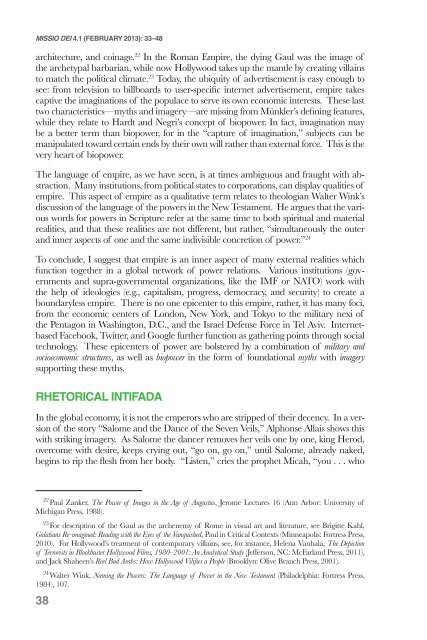VULNERABLE MISSION
VULNERABLE MISSION
VULNERABLE MISSION
You also want an ePaper? Increase the reach of your titles
YUMPU automatically turns print PDFs into web optimized ePapers that Google loves.
MISSIO DEI 4.1 (FEBRUARY 2013): 33–48<br />
architecture, and coinage. 22 In the Roman Empire, the dying Gaul was the image of<br />
the archetypal barbarian, while now Hollywood takes up the mantle by creating villains<br />
to match the political climate. 23 Today, the ubiquity of advertisement is easy enough to<br />
see: from television to billboards to user-specific internet advertisement, empire takes<br />
captive the imaginations of the populace to serve its own economic interests. These last<br />
two characteristics—myths and imagery—are missing from Münkler’s defining features,<br />
while they relate to Hardt and Negri’s concept of biopower. In fact, imagination may<br />
be a better term than biopower, for in the “capture of imagination,” subjects can be<br />
manipulated toward certain ends by their own will rather than external force. This is the<br />
very heart of biopower.<br />
The language of empire, as we have seen, is at times ambiguous and fraught with abstraction.<br />
Many institutions, from political states to corporations, can display qualities of<br />
empire. This aspect of empire as a qualitative term relates to theologian Walter Wink’s<br />
discussion of the language of the powers in the New Testament. He argues that the various<br />
words for powers in Scripture refer at the same time to both spiritual and material<br />
realities, and that these realities are not different, but rather, “simultaneously the outer<br />
and inner aspects of one and the same indivisible concretion of power.” 24<br />
To conclude, I suggest that empire is an inner aspect of many external realities which<br />
function together in a global network of power relations. Various institutions (governments<br />
and supra-governmental organizations, like the IMF or NATO) work with<br />
the help of ideologies (e.g., capitalism, progress, democracy, and security) to create a<br />
boundaryless empire. There is no one epicenter to this empire, rather, it has many foci,<br />
from the economic centers of London, New York, and Tokyo to the military nexi of<br />
the Pentagon in Washington, D.C., and the Israel Defense Force in Tel Aviv. Internetbased<br />
Facebook, Twitter, and Google further function as gathering points through social<br />
technology. These epicenters of power are bolstered by a combination of military and<br />
socioeconomic structures, as well as biopower in the form of foundational myths with imagery<br />
supporting these myths.<br />
RHETORICAL INTIFADA<br />
In the global economy, it is not the emperors who are stripped of their decency. In a version<br />
of the story “Salome and the Dance of the Seven Veils,” Alphonse Allais shows this<br />
with striking imagery. As Salome the dancer removes her veils one by one, king Herod,<br />
overcome with desire, keeps crying out, “go on, go on,” until Salome, already naked,<br />
begins to rip the flesh from her body. “Listen,” cries the prophet Micah, “you . . . who<br />
38<br />
22 Paul Zanker, The Power of Images in the Age of Augustus, Jerome Lectures 16 (Ann Arbor: University of<br />
Michigan Press, 1988).<br />
23 For description of the Gaul as the archenemy of Rome in visual art and literature, see Brigitte Kahl,<br />
Galatians Re-imagined: Reading with the Eyes of the Vanquished, Paul in Critical Contexts (Minneapolis: Fortress Press,<br />
2010). For Hollywood’s treatment of contemporary villains, see, for instance, Helena Vanhala, The Depiction<br />
of Terrorists in Blockbuster Hollywood Films, 1980–2001: An Analytical Study (Jefferson, NC: McFarland Press, 2011),<br />
and Jack Shaheen’s Reel Bad Arabs: How Hollywood Vilifies a People (Brooklyn: Olive Branch Press, 2001).<br />
24 Walter Wink, Naming the Powers: The Language of Power in the New Testament (Philadelphia: Fortress Press,<br />
1984), 107.


